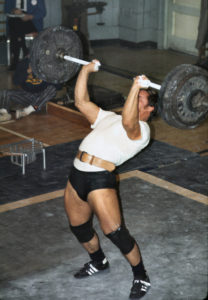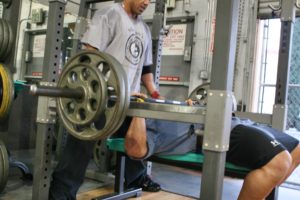
By Strength Sensei CP
Publication Date: 1996
Isometrics reached its peak in popularity several decades ago when the famous York Barbell Club company promoted this training method in their publications, Strength and Healthand Muscular Development. At the time, York sponsored several members of the U.S. Weightlifting Team, and much of their success in increasing strength was attributed to performing isometrics in a power rack. York sold lots of power racks as a result, but hardcore Iron Game athletes questioned the value of isometrics and soon lost interest. This is unfortunate because many of the isometric training methods developed for the power rack are quite effective for gaining muscle mass and breaking strength plateaus.

In the 60s, many elite weightlifters performed isometric training methods to increase their strength, especially for lifts such as the Olympic press. Shown is Bob Bednarski, a U.S. lifter who set 12 world records, four in the Olympic press, and won the 1969 World Weightlifting Championships. (Bruce Klemens photo)
To show you how power rack training can take you to the next level of strength and size, let’s look at some facts regarding isometric training:
— During an isometric contraction, a muscle contracts, yet no external movement occurs.
— Although no external movement occurs during an isometric contraction, there is an internal shortening of the muscle belly to “take up the slack,” so to speak. The only way a muscle could not change its length would be if it were injured, either by not receiving any nerve stimulation or by being in a state of permanent spasm.
— In many athletic activities, an isometric contraction of the legs in the set position precedes a concentric contraction. Examples include exploding out of the starting blocks in sprinting or preparing to lift a barbell from the floor during a clean and jerk. This type of muscle action enables the athlete to produce a stronger concentric contraction at the start.
— A muscle can produce 10-15 percent more force during isometric contractions than during concentric contractions.
— A muscle will gain strength at the precise angle an isometric contraction is performed, plus or minus 15 degrees. That is, if you train isometrically at 45 degrees of elbow flexion, you gain strength through 30-60 degrees of elbow flexion (45 degrees, plus or minus 15 degrees).
— Isometric contractions should last between 6-8 seconds and be maximal. However, to avoid injury, there should be a gradual “tensing-up” of the muscle, followed by progressive relaxation.

The start position of the Olympic lifts involves isometric contractions of the legs. Shown is the popular Spanish weightlifting champion Lidia Valentín Pérez. Pérezwon silver in 2008, gold in 2012, and bronze in 2016. (Photo by Tim Scott @liftinglife)
Isometronics: The Next Generation of Isometrics
Because I’m a strong advocate of power rack training, I want to share with you two extremely effective isometrics workouts, one for the biceps and one for the triceps. I developed these workouts by combining ideas from articles by Anthony Ditillo and the late Don Ross. I guarantee you these programs work! I found that intermediate bodybuilders who used these workouts increased their standing curling poundages by 5-25 pounds and their close-grip bench press poundages by 30-45 pounds in just 3-4 weeks!
These workouts make use of what exercise physiologists call “functional isometric contractions.” In the early ‘60’s, this method was known in the Iron Game as “isometronics,” which is a contraction of the terms isometrics and isotonics (or, more properly, auxotonics). The theory behind this workout system was that although isometrics can be a valuable adjunct to training, it lacks the dynamic component of regular lifting, known as isotonics.
With isometronics, you take advantage of the joint angle specificity of strength gains caused by isometric training. Thus, during every set performed in the power rack, you’ll perform a functional isometric contraction afterpre-fatiguing the muscle with heavy partial repetitions.

The power rack enables you to start and finish an exercise at precise joint angles. (Miloš Šarčev photo)
For both the biceps and triceps workouts presented in the next section, you’ll be working at three ranges – low, middle, and top. For each of these ranges, you’ll select a weight you can move from the starting position to pins (i.e., bar catches) placed at the end of the range of motion. For both of these routines, you’ll need two sets of pins – one for the start position and one for the end position. Here’s how to do it:
- Place the power rack pins in the specified positions (see the next section).
- Standing in front of the power rack, perform four to six partial reps in the normal fashion.
- When you come to the end of the last concentric repetition, press the bar against the top pins. Press as hard as possible for 6-8 seconds – try to rip through the pins! Don’t hold your breath during the isometric contraction; instead, use a very brief cycle of breathing, alternating rapidly between short inhaling and short exhaling.
- If you’ve performed this set properly, you should not be able to perform another repetition – if you can, the weight was too light.
Isometronic Biceps Workout
The isometronic biceps workout involves performing nine sets of rack work; 3 sets of 4-6 reps of isometronics performed at three different ranges. Don’t be surprised if you’re prone to intense shaking after you complete the routine—this is evidence that your nervous system is shot. Due to the severity of this workout, it should be performed only once every other biceps workout.
Low-Range Barbell Curl.Set the pins in the power rack at a point where the barbell will travel for 45-50 degrees of your range of motion, starting from the bottom position (arms extended). At this angle, the range is quite limited, so take only two seconds to lower the barbell. This exercise will improve power at the start of all curling exercises.
Mid-Range Barbell Curl.Set the pins in the power rack at a point where the barbell will travel for 80-90 degrees of elbow flexion. For this range, take three seconds to lower the barbell. This is where most individuals encounter sticking points when performing conventional, full-range barbell curls. These functional isometric contractions will help you blast through these sticking points!
Top-Range Barbell Curl.Set the pins in the power rack at a point where the barbell will travel for 130-140 degrees of elbow flexion. Maintaining proper ergonomics is hardest in this range. As you fatigue, you’ll tend to lean back, a technique fault that creates trauma in the lower back that can cause injury. To prevent you from swinging the weight, have a training partner support you with his or her back against yours. You’ll perform 3 sets of 4-6 reps of isometronics in this range, resting three minutes between each set.



Isometronics uses several positions of flexion, including low range (left), mid-range (center), and top range (right). (Miloš Šarčev photos)
Once you’ve completed these nine sets in the power rack, finish your routine by performing one of the following options:
Option A
Barbell Curl (full range), 1 x 6-8 RM, 4011 tempo. (Note: RM is repetition maximum, which is the most weight you can use for the prescribed number of reps. For the tempo prescription, the first number is the lowering portion of an exercise, the second is the pause in the weakest position, the third is the lifting portion, and the fourth is the pause in the strongest position.)
EZ Bar Reverse Curl, 3 x 6-8 RM, 4121, rest 3 minutes
Option B
Barbell Curl (full range), 1 x 6-8 RM, 4011
Incline Dumbbell Curl, 3 x 6-8 RM, 3131, rest 3 minutes
Option C
Barbell Curl (full range), 1 x 6-8 RM, 4011
Scott Close-Grip Curl, 3 x 6-8 RM, 5111, rest 3 minutes
On your alternate biceps workouts, don’t use the power rack. Instead, perform 4 sets of 4-6 reps of barbell curls (full range), 4011, followed by option A, B, or C.
Isometronic Triceps Workout
You’ll perform 3 sets of 4-6 reps of isometronics at each one of these ranges, starting from the bottom position. Rest three minutes between each set. Due to the severity of this workout, it should be performed only every other triceps workout, or about once every 10 days.

Egyptian bodybuilder Tarek Elsetouhi shows the level of triceps development he achieved through hard, intelligent training. (Miloš Šarčev photo)
Low-Range Close-Grip Bench Press.Set the pins in the power rack at a point where the bar will travel from an inch off your chest to four inches above the chest. This should be your weakest position; in fact, some 300+ bench pressers will have to start with as low as 165-185 pounds. At this angle, the range is quite limited, so take two seconds to lower the bar. You’ll find that training in this range will give you an explosive start off the chest in the bench press. Perform 3 sets to 4-6 reps of isometronics at this range, resting three minutes between each set.
Mid-Range Close-Grip Bench Press.Set the pins in the power rack at a point where the bar will travel from four inches off the chest – the end position of your set – to eight inches above the chest. Lower the bar in two seconds. You’ll find that maintaining the groove in this particular exercise requires considerable concentration.
Top-Range Close-Grip Bench Press.Set the pins in the power rack at a point where the bar will travel from 8 inches off your chest – the end position of your set – to 95 percent of lockout. At this range, you should be able to handle loads well above your mid-range bench press.
Once you’ve completed these nine sets in the power rack, finish your routine by performing one of the following options:
Option A
Close-Grip Bench Press (full range), 1 x 6-8 RM, 4011
Decline Barbell Triceps Extension, 3 x 6-8 RM, 4021, rest 3 minutes
Option B
Close-Grip Bench Press (full range), 1 x 6-8 RM, 4011
Low-Pulley Rope French Press, 3 x 6-8 RM, 2211, rest 3 minutes
Option C
Close-Grip Bench Press (full range), 1 x 6-8 RM, 4011
Parallel Bar Dip, 3 x 6-8 RM, 3111, rest 3 minutes
On your alternate triceps workouts, don’t use the power rack. Instead, perform 4 sets of 4-6 reps of close-grip bench presses (full range), tempo 4011, followed by option A, B, or C.
Try this style of training, and see for yourself how an old concept like isometrics can be adapted to modern methods and lead to unprecedented growth!
